José Galvão does not look much like an elf. At 79, he has the weather-burned face and strong labourer’s hands of a man born in the mountains of central Portugal. Yet, for months he’s been beavering away behind the scenes to bring to life what must be one of the world’s friendliest and least showy Christmas celebrations.
Every Christmas for the past eight years, the 170 or so residents of Cabeça in the Serra de Estrel mountain range transform their remote village into a rustic winter wonderland. The idea sprang from a competition run in 2013 by the local council, but has since taken on a life of its own, attracting a growing flow of visitors from across Portugal every year.
Sitting just off the central plaza with some of his old-boy friends, José breaks off his chinwag to show me the three-inch folding knife in his pocket. “I’m no expert, but I do a bit of carving,” he chortles through a gap-toothed smile. “We’ve all got to muck in, certo? Cabeça is the Christmas Village after all.”
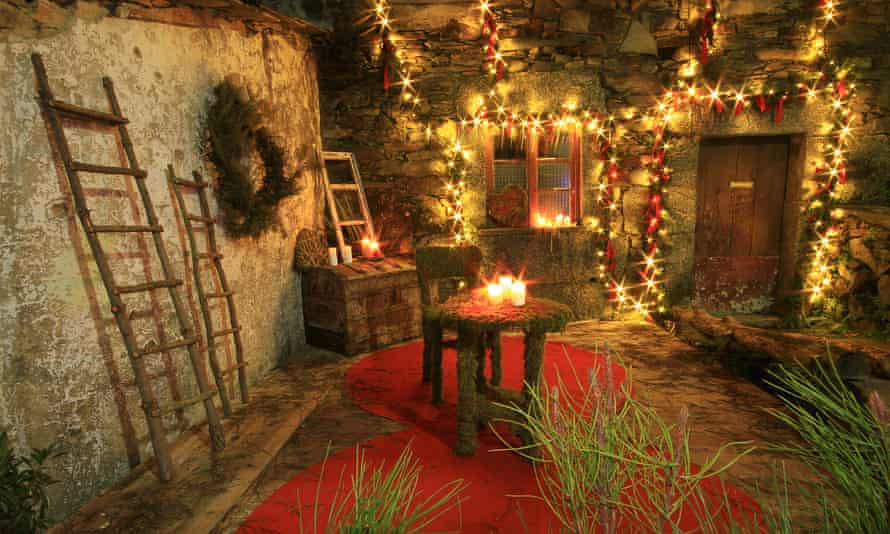
He is right on every count. Following his directions, I walk 100 metres or so down one of Cabeça’s narrow streets. Pop-up stores and market stalls line the route, which is busy with Portuguese day-trippers on the hunt for festive fun.
I briefly stop at Loripão, a bakery from the next-door village, which has rented a villager’s front room for the fortnight’s celebrations. It’s a paradise of all things sweet and sugary, and its biggest seller by far is the bolo rei (king cake) – the rounded sugary bread topped with crystalised fruits that adorns every Portuguese sideboard at Christmas.
Outside, decoration are strung between the square granite houses that characterise the local architecture. Everything is homemade, from the heart-shaped frames swaddled in ferns to the moss-covered stars studded with red berries.
The only exception is the thin string of tiny, white Christmas lights that flows higgledy-piggledy between the houses, over the parish church, and around Café Dias – the only business in Cabeça that is open year-round.
When the sun sets and the switch is flicked, the hilltop village – hemmed in as it is by steep forested slopes and blanketed in mid-winter darkness – lights up like the Star of Bethlehem.
By the steps up to an ancient stone house, I find José’s yuletide contribution. It’s a loving attempt at creating the nativity family, with each figure, carved roughly from a thin tree trunk, about waist height.
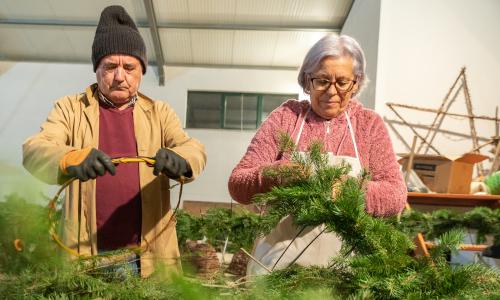
Pine-tree straight, they don’t have arms or legs, but each has a beatific countenance, graced with crossed eyes, wonky noses and winsome whittled smiles. Joseph even has a flowing, pine-leaf wig, while the baby Jesus is crowned with a nest of autumn leaves.
Leaving the happy family, I head up the stairs into what an etched wooden sign describes as the Oficina de Natal (Christmas workshop). The single-room space is quite different from the tat-filled, depot-style emporiums that are the popular image of Santa’s workplace. There’s no shiny tinsel or tacky garlands, nor any plastic packaging or – praise the Lord and the Angel Gabriel – Christmas jingles or mawkish piped carols.
Instead, as with the decorations that deck the village, the products for sale are resolutely artisanal. All are made from materials available in the hills around: painted pine cones and woollen baubles, wooden angels and bracken wreaths.
It doesn’t take long for Portugal’s only “Christmas Village” to work its magic. Within minutes, the stresses of last-minute shopping and present wrapping dissipate.
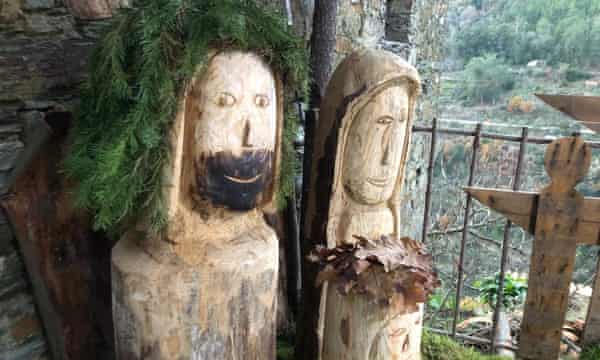
With an average age of about 68 and only three children under 15, Cabeça knows everything there is to know about taking things slow. I get into the groove with a gentle hike down into the valley. The steep, circular route takes me over terraces of crooked-armed olive trees and down to an ice-cold river. Abandoned stone settlements dot the path, a reminder of the centuries that this secluded community has lived through.
The walk leaves me hungry. On Christmas Eve, millions of Portuguese sit down to an evening feast of bacalhau (salt cod) and boiled potatoes, followed by aletria (an egg-noodle dessert). But in landlocked Cabeça, hearty mountain fare dominates; caldo verde (vegetable broth), morcela (black pudding), alheira (a garlicky sausage stuffed with breadcrumbs), and pica pau (seasoned fried beef).
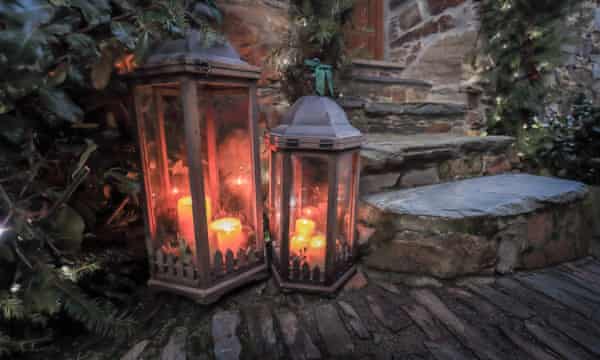
I grab a rickety table in a pop-up restaurant in the basement of a two-storey house. Not so long ago, the low-roofed eatery would have been a home for cattle and sheep. The straw and manure are gone, but the stable-like atmosphere feels appropriate.
Portugal’s Christmas Village may be steeped in back-to-basics nostalgia, but it’s far from staid. As well as soaking up the atmosphere (and the local aguardente liquors), visitors can enjoy a series of programmed events throughout the two-week season. Highlights include choral concerts, cooking classes and craft workshops.
But Cabeça is not the only rural hideaway in Serra da Estrela that throws open its doors to visitors. The 42-strong Mountain Villages network arranges cultural celebrations throughout the year, such as a folk festival in Lapa dos Dinheiros in June, and summer sheep-blessings in Foldosa da Madalena.
“It’s a way of not just keeping the traditions alive in these remote villages, but celebrating them,” says Célia Gonçalves, director of the Mountain Villages network and coordinator of the original competition that gave life to Portugal’s Christmas Village. “The pride the villagers get from showing off their culture like this is amazing.”
With the night now long drawn in, it’s time to take my leave. Before going, I return one last time to pay my respects at Senhor Galvão’s nativity scene. The baby Messiah is still grinning gayly, his mountain home evidently glad tidings of great joy.
The Christmas Village runs until 2 January. The trip was provided by the Center of Portugal Tourism Board (guided by Madomis Tours). Cabeça is a 20-minute taxi ride from Seia, which is well served by buses (Lisbon 4 hours, Porto 3.5 hours). Hotel Casa de Baixo, half an hour away in Alvoco das Várzeas, has doubles from €100 B&B
Five more Christmas-y places in Europe
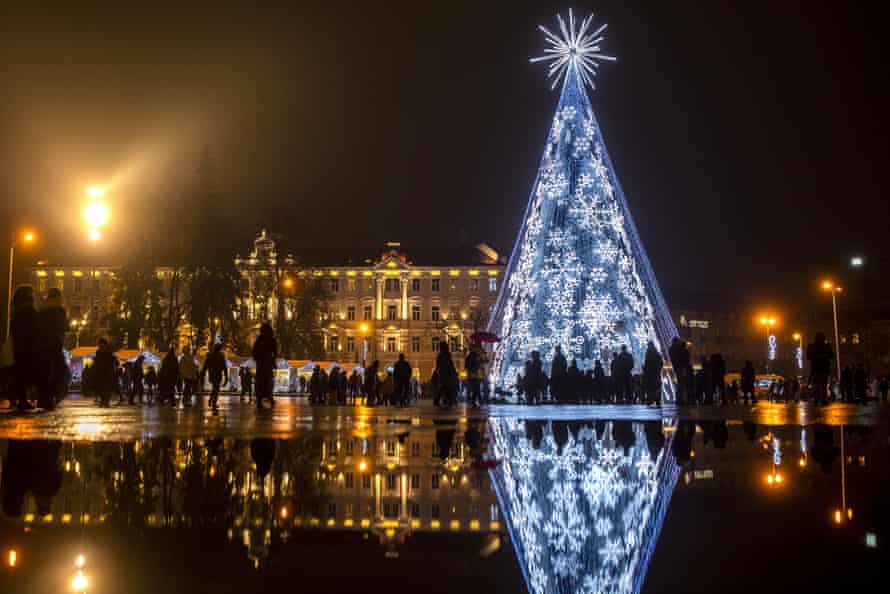
Vilnius, Lithuania
Lisbon’s Praça do Comércio, New York’s Rockefeller Center, Strasbourg’s Place Kléber and Rio de Janeiro’s Rodrigo de Freitas Lagoon are all famed for their annual Christmas tree extravaganzas. But vying to outdo them is the Cathedral Square in Vilnius, which since 2015 has played host to increasingly discombobulating arboreal creations. Featuring giant snowflakes, this year’s stunning exhibit comprises a 27-metre, icicle-white cone topped by a huge shining star. Past themes have included fairytales, chess and the colour purple.
Tallinn, Estonia
Every neighbourhood has that one house that is fully decked out with twinkly lights and illuminated reindeer. Well, in Tallinn, make that every house. And park. And square. And street. Estonia’s walled capital defies the seasonal darkness by drenching its medieval centre with more than 300 light installations. Especially luminescent is Vabaduse Square, where light fountains shoot upwards into the winter sky.
Bruges, Belgium
A favourite Christmas destination for decades, the canal-crossed Belgian city is pushing the boat out even more than usual this year with its city-wide Winter Glow festival. Take a stroll along the glittering “Light Trail” as it winds through the city’s cobbled, Christmas tree-lined streets. Take your pick from three Christmas markets: Market Square, Simon Steven Square and Zand Square.
Colmar, France
Don’t go to Disneyland Paris for a fairytale Christmas; the ancient Alsatian town of Colmar offers the real thing. With five separate markets, the town embraces the yuletide spirit with elfish gusto. As well as an 800 square-metre ice rink and an old-school carousel, check out the Christmas-themed wine cellars and gondola-riding children’s choir. Look out for the night watchman who walks the ramparts every night, as his predecessors have done since the middle ages.
Prague, Czech Republic
Many Christmases ago, Good King Wenceslas looked out over Prague and – so the carol goes – saw the snow lying “deep and crisp and even”. Today, few places are more lively than the Czech capital at yuletide, with the streets thronging with partygoers, shoppers and tourists throughout December. The city’s famous Christmas market is officially postponed this year, but pop-up Christmas stalls still abound and fixed venues such as Havel’s Market are tinselled up to the nines. One tradition not to miss is the lighting of Charles Bridge’s gas lamps at dusk (around 4pm) each day.





